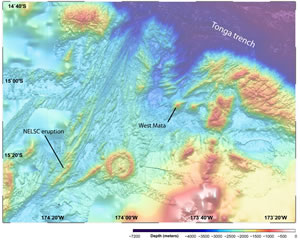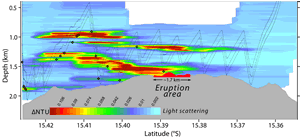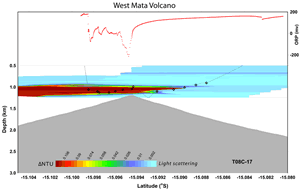2008-2009 NE Lau
Midocean ridge eruptions offer rare opportunities to study the creation of new ocean crust and the accelerated release of heat and chemicals into the ocean. Only seven such events have been documented since the first observation of eruption-induced fluid discharge in 1986. Their hallmark is “event plumes,” symmetrical boluses of hydrothermally rich water typically ~0.5 km thick and 5-20 km in diameter. In Nov. 2008 on the Northeast Lau Spreading Center, we detected not a typical event plume but a uniquely different series of young, apparently eruption-generated plumes, each <~100 m thick. These plumes had unusually intense light-scattering (NTU>0.6), oxidation-reduction potential (ORP or “Eh”) (>250 mv), temperature (ΔT >0.7°C) and H2. These characteristics implied very young plumes. Our observations demonstrate that event plumes can also occur as thin layers rising >1 km that still contain intense hydrothermal anomalies. The observations also provide new constraints on the debate on event plume formation—by sudden cooling of erupting lava or the release of fluids from a crustal reservoir.
Concurrently with the observation of an eruption on the Northeast Lau spreading center we detected strong evidence of an ongoing eruption at the summit of a nearby volcano. West Mata lies ~ 60 km NE of the NELSC, near the Tonga arc. Unusually intense hydrothermal plumes were found from the ~1200-m-deep summit up to ~1000 m. Light scattering anomalies of dNTU>1.0 were present throughout the plume, and exceeded the maximum detection limit of the sensor (dNTU=5.0) for more than 10 minutes while the CTD was within this depth range. The bottom 50 m of the water column had an average temperature anomaly of 0.8°C, spiking to 2.0°C near the seafloor. The oxidation-reduction potential (ORP) plunged dramatically within the particle plume, reaching a maximum anomaly of more than 750 mV near the seafloor. These eruption indications were confirmed in May 2009 to be the product of an ongoing submarine volcanic eruption with more than one active vent near the summit.
Baker, E. T., F. Martinez, J. A. Resing, S. L. Walker, N. J. Buck, and M. H. Edwards (2010), Hydrothermal cooling along the Eastern Lau Spreading Center: No evidence for discharge beyond the neovolcanic zone, Geochem. Geophys. Geosyst., doi:10.1029/2010GC003106. (PDF)
Walker, S.L, E.T. Baker, J.E. Lupton, J. Resing, P.V. Crowhurst, R. Greene, and N. Buck (2009), Near and far field particle plumes around an erupting volcano - W Mata, NE Lau Basin, Eos Trans. AGU, 90(52), Fall Meet. Suppl., Abstract V51D-1717.
Resing, J.A., and R.W. Embley (2009), Active eruptions in the NE Lau Basin, Eos Trans. AGU, 90(52), Fall Meet. Suppl., Abstract V43I-01.
.



